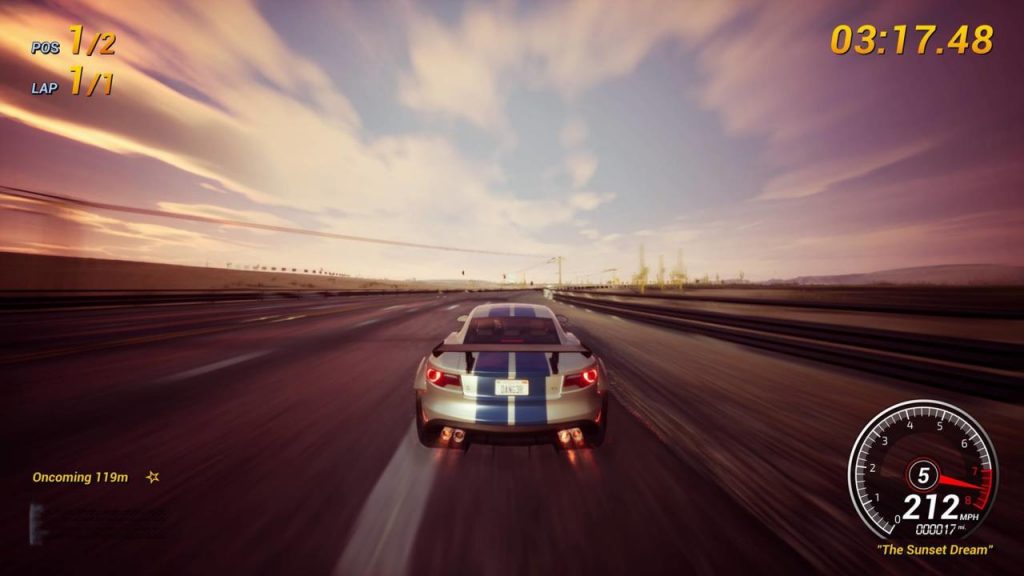Dangerous Driving Review – Burnt Out. It’s impossible to play or talk about Dangerous Driving without comparing it to Criterion’s seminal Burnout 3: Takedown. This is by design, of course, as developer Three Fields Entertainment–a small indie studio comprised of former Criterion alum–set out to create a spiritual successor to the dormant racer; latching onto the groundbreaking Burnout 3 as a clear and popular focal point. Everything about Dangerous Driving’s design, right down to small details like font selection and the phrasing used in its loading screens, is distinctly Burnout 3. It foregoes the advances made in its sequels–like traffic checking and the introduction of an open-world–to hone in on what made Takedown so special.
My first hour or so with Dangerous Driving was fraught with bewilderment, however. There’s a single song that plays on the main menu, but other than this there’s a complete absence of music throughout the entire game. Licensed tracks are a crucial component to the Burnout formula, and after playing a few events in near-complete silence, their monumental importance can’t be overstated. Obviously, this is true of most games, but particularly one where high-speed exhilaration is on the menu. After initially thinking this was either a bug or that music would eventually find its way into the game via a day one patch, I hopped into the audio settings and discovered the reason for its omission: Spotify integration.
This is a smart idea for an indie studio that might not have the budget to splash out on licensed music, and after finding something suitably upbeat and aggressive myself, the experience of tearing around the track and wrecking other cars was improved tenfold. Yet asking people to own a premium service just to get music in their game is a fairly excessive compromise. It’s an understandable trade-off for gaining access to popular music in a budget-priced game, but beyond the monetary requirement, it also has an effect on gameplay. Three Fields can’t manipulate Spotify music in any way, so songs will just play through from start to finish without the incorporation of any interactive elements. This means that the music doesn’t change its tone when you boost, or slow down and warp during takedowns, and that robs these moments of some of their potential impact.

When you’re out on the road, the handling of each car will feel instantly familiar to anyone who’s ever played Burnout before. While most contemporary racing games are wary of fully embracing an arcadey style without featuring some kind of simulation element, Dangerous Driving is a full-blooded, balls-to-the-wall arcade racer. You’ll hold down the accelerator ad infinitum until your finger aches, careen around corners by either scraping across the steel guard rails or tapping the brake button to effortlessly drift around, and weave between oncoming traffic at over 200-miles-per-hour as the nitrous oxide flames spewing out of each exhaust pipe propel your car forward.
Unfortunately, the physics can be fairly wonky at times, often bringing your vehicle to a complete stop because you brushed against a wall; while other times it will shoot you straight up into the air, or force your car into a complete 90-degree turn. This can be incredibly frustrating during the latter stages of an event when one mishap is enough to send you tumbling to the back of the pack. Collision detection is also inconsistent; numerous times a head-on crash resulted in my car clipping through the floor and appearing unscathed on the other side. The face-distorting sense of speed, though, is genuinely electric, and the PS4 Pro version maintains a stable 60 frames-per-second with one notable exception: It has a tendency to hitch rather egregiously when you’re driving through tunnels.
The crux of Dangerous Driving’s racing is centered around the need to drive recklessly and constantly put yourself in harm’s way. By hurtling towards incoming traffic, performing near misses, nailing drifts, tailgating, and taking down your opponents, you earn variable degrees of boost that will help fire your chosen vehicle towards the finish line. There isn’t a discernible difference in how each car handles, other than the fact that some go faster than others, but their pinpoint responsiveness coupled with the high framerate ensures that you’re fully capable of serpentining in and out of danger if your reactions are quick enough. Again, this is quintessential Burnout, with the destruction of your fellow drivers doubling your boost meter and incentivizing the most perilous behavior possible. These takedowns are reminiscent of those that debuted in Burnout 3, although the slow-motion crashes in Dangerous Driving are surprisingly underwhelming. They’re not bad, but they’re also not impactful enough–which the aforementioned issues with music contribute to–lacking in any real dynamism or metal-crunching detail.
=> Click learn to fly idle cool math play game free now.





